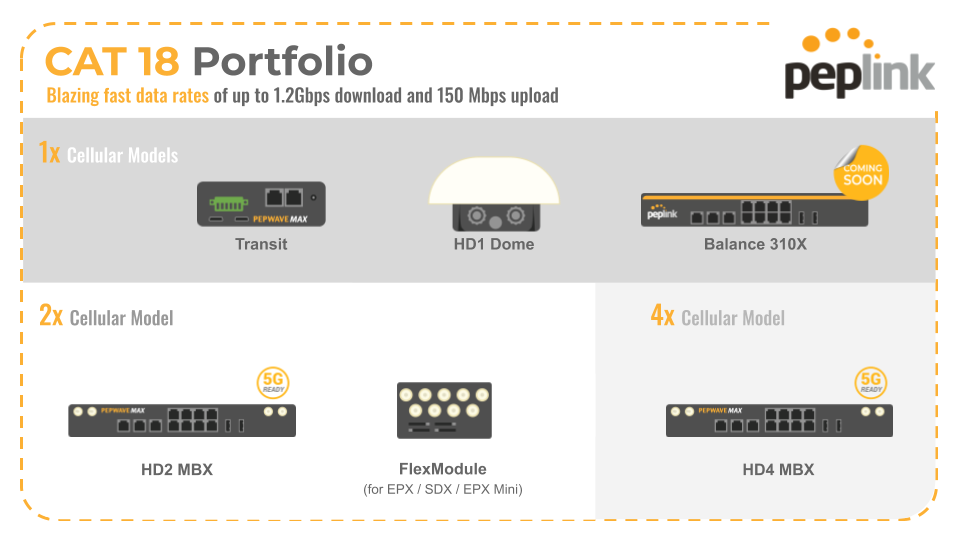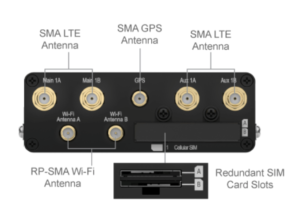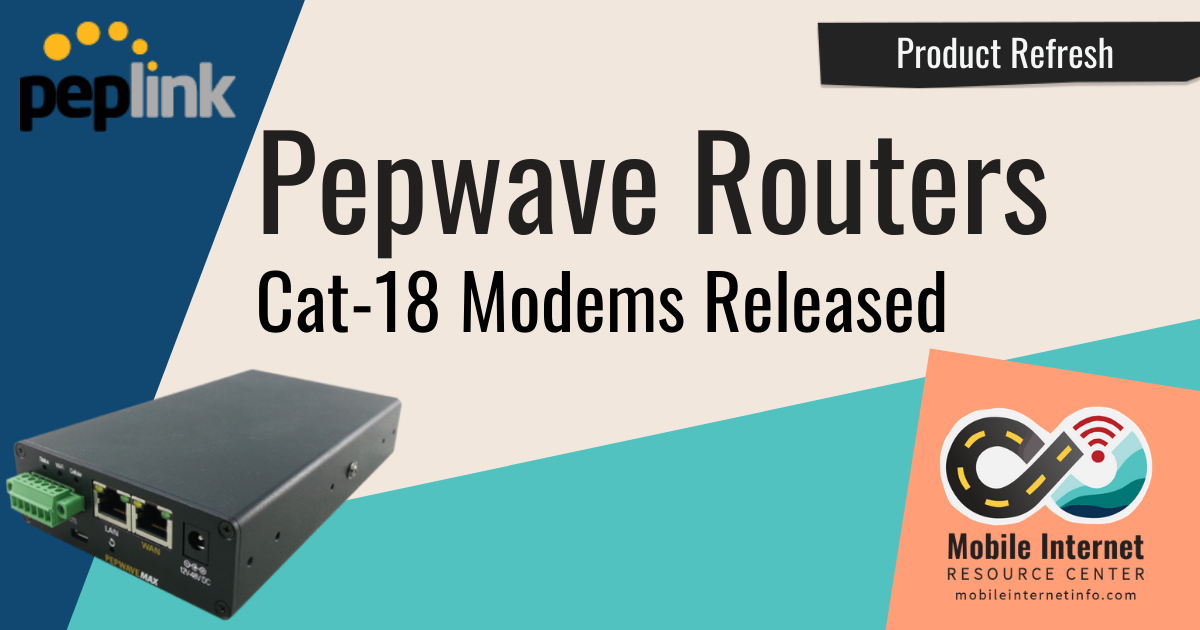Peplink today announced that it has updated a few of its cellular integrated Pepwave router products with integrated LTE Category 18 modems, support for 4x4 MIMO antennas, and compatibility with more cellular frequencies - including T-Mobile's long-range LTE Band 71.

This is a long-awaited upgrade, since Peplink competitor Cradlepoint has had Cat-18 offerings (our news story) for over a year now.
But not all Pepwave models are getting the newer modem chipset - and customers interested in the MAX Transit will now face a dilemma - go with a single Cat-18 modem with 4x4 MIMO or two Cat-12 modems as found in the current MAX Transit Duo.
Table of Contents
Video Version
Subscribe to our YouTube Channel
Peplink’s Cat-18 Lineup
Category 18 modems are "gigabit-class" LTE modems, capable of combining up to 5x different frequency bands via carrier aggregation. Beyond carrier aggregation, Cat-18 modems rely on 4x4 MIMO antennas for improved reception in weak areas and potentially doubled speeds in strong signal areas when compared to what 2x2 MIMO is capable of.
Category 18 is near the pinnacle of 4G/LTE evolution - and represents just about the best pre-5G cellular technology available.
Here is how Peplink describes the advantages of the new models:
Want the best reception and fastest cellular we have? Want it now? Then CAT 18 routers are just the thing you need.
They are equipped with up to 4x4 MIMO and support a wider range of frequencies, ensuring the best signal reception.
If you need speed, our X-Series (MBX, EPX, SDX) supports up to 1.2Gbps download and 150Mbps upload per radio. With carrier aggregation, they can combine up to 5x frequencies for blazing fast downloads.
Here are the key mobile models in the new Cat-18 lineup:
- MAX Transit (Cat 18) with PrimeCare - $749 - Externally nearly identical to the Cat-12 MAX Transit Duo, the Cat-18 model has one modem with four antennas instead of two modems with two antennas each. An ongoing $69/year PrimeCare support contract (see our MAX Lineup for information on PrimeCare) is required to enable certain advanced features, though the first year of PrimeCare is free.
- MAX HD1 Dome (Cat 18) $1,499 - The current MAX HD2 Dome featured one Cat-12 and one Cat-6 modem (and no Wi-Fi) in an outdoor-rated dome for vehicle rooftops, and cost $3,499. The new HD1 Dome seems to be an identical design, but with a single Cat-18 modem with four antennas under the dome instead. Because it has just a single modem, there is no support for bonding or load balancing.
- MAX HD2 MBX (Cat-18) - $6,999 - The HD2 has two Cat-18 modems, and an underlying X-Series router capable of fully taking advantage of them with 2.5Gbps of router throughout - over 6x the raw processing capability of the 400Mbps MAX Transit. The HD2 also has two USB ports for tethering as well, allowing you to load balance or bond across all of these connections simultaneously.
- MAX HD4 MBX (Cat-18) - $9,999 - The same as above, but with 4x Cat-18 modems - making it the new flagship of the Pepwave line. The Cat-12 version of the HD4 MBX is still available for $7,999.
Almost all of this lineup is way out of the reach of most mobile consumers, but the MAX Transit remains an enticing option that will certainly appeal to some.
NOTE: Do be aware that the MAX Transit's CPU can only handle routing internet traffic at a peak speed of 400Mbps - and it is theoretically possible under some ideal conditions that the Cat-18 modem will actually be handicapped by that router limit when it would otherwise be able to go faster. But considering the cost premium for an X-Series router that can keep up with true gigabit cellular speeds, this is not likely to be a concern for most mobile mortals.
New LTE Bands
Every new generation of Pepwave router has added support for new cellular bands:
The old Cat-6 Pepwave modems supported these LTE bands:
B1, B2, B3, B4, B5, B7, B8, B12, B13, B20, B25, B26, B29, B30, B41
The FirstNet / Cat-12 modem supported these LTE bands:
B1, B2, B3, B4, B5, B7, B8, B9, B12, B13, B14, B18, B19, B20, B26, B29, B30, B32, B41, B42, B43, B46, B48, B66
The Cat-12 models covers almost every LTE band in use in North America and is well suited for global roaming as well.
And the new Cat-18 modems cover:
B1, B3, B25(B2), B66(B4), B26(B5/B18/B19), B7, B8, B12(17), B13, B14, B20, B28, B29, B30, B32, B71, B38, B39, B40, B41, B42, B43, B46, B48.
The major significant addition here is LTE Band 71, the long-range 600MHz spectrum that T-Mobile relies on for its longest-range service. For those that rely on T-Mobile, this addition alone might make the jump to Cat-18 worthwhile.
Pepwave Pondering: Two Cat-12 or One Cat-18?
The Pepwave MAX Transit lineup is getting crowded.
Here are the models that are the most tempting:
- Cat-6 Lineup
- MAX Transit Duo (Cat-6) with PrimeCare ($799) - Two Cat-6 modems.
- Cat-12 Lineup
- MAX Transit Duo (Cat 12) with PrimeCare ($999) - Two Cat-12 modems.
- Cat-18 Lineup
- MAX Transit (Cat 18) with PrimeCare ($749) - Just a single Cat-18 modem.

Other than the modem modules - these are identical routers, with the same Wi-Fi and router capabilities.
The question comes down to deciding which is more important - the reliability of being able to be connected to two different cellular carriers at once with the dual-modem models, or the potential increases in peak speed and remote signal sensitivity from the single-modem Cat-18 model with support for four antennas?
We have been extremely impressed with the dual-modem Cat-12 MAX Transit Duo we have been testing for the past several months, and have recently awarded it our "Top Pick" status.
The flexibility that comes from being able to instantly switch between carriers in the Duo models is hard to beat.
But if you do not keep multiple active cellular plans in a router, the lower cost and potential for faster peak speeds of the Cat-18 model makes a ton of sense.
There is no one simple universal answer - it all depends on your needs.
What About The Rest Of The Pepwave Lineup?
We'd be surprised to see any additional Pepwave lower-end routers make the jump to Cat-18 anytime soon.
Redesigning the older single-modem device like the MAX BR1 Classic to have faster internals and support for 4x external antennas is probably just not worth the effort.
But hopefully, Pepwave is working on eventually bringing the faster underlying technology in its X series of routers down to more mainstream approachable prices - and we will see upgrades like this in the years ahead as 5G technology become widely available.
NOTE: MIA members - be sure to read this post while logged in to see an exclusive discount on this new Pepwave hardware from MobileMustHave that we are able to share with you.
Member Exclusives Below:
Bonus Member Only Content Available!
We go extra for our premium members - who make this resource center possible (did you notice the lack of 3rd Party advertising?). We have included some additional information in this news article just for our members - analysis, guidance and/or insider tips.
If you're not yet a member, please consider joining us. Extra content like this is one of the many perks we offer - in-depth content, guidance, discounts, alerts, classroom and more.

If you are already a member, please log in above to see the special content we have prepared for you.
Related Reading & Updates
Pepwave News Stories:
Additional Resources:
- Guide: Selecting a Mobile Router - Bringing Mobile Internet Options Together and Creating a Local Network
- Guide: LTE Modem Specifications And Selecting Cellular Data Devices (MiFi, Jetpacks, Routers, Phones)
- Guide: Understanding & Optimizing Your Cellular Data Performance
- Guide: Understanding Cellular Frequencies








 Mobile Internet Resource Center (dba Two Steps Beyond LLC) is founded by Chris & Cherie of
Mobile Internet Resource Center (dba Two Steps Beyond LLC) is founded by Chris & Cherie of